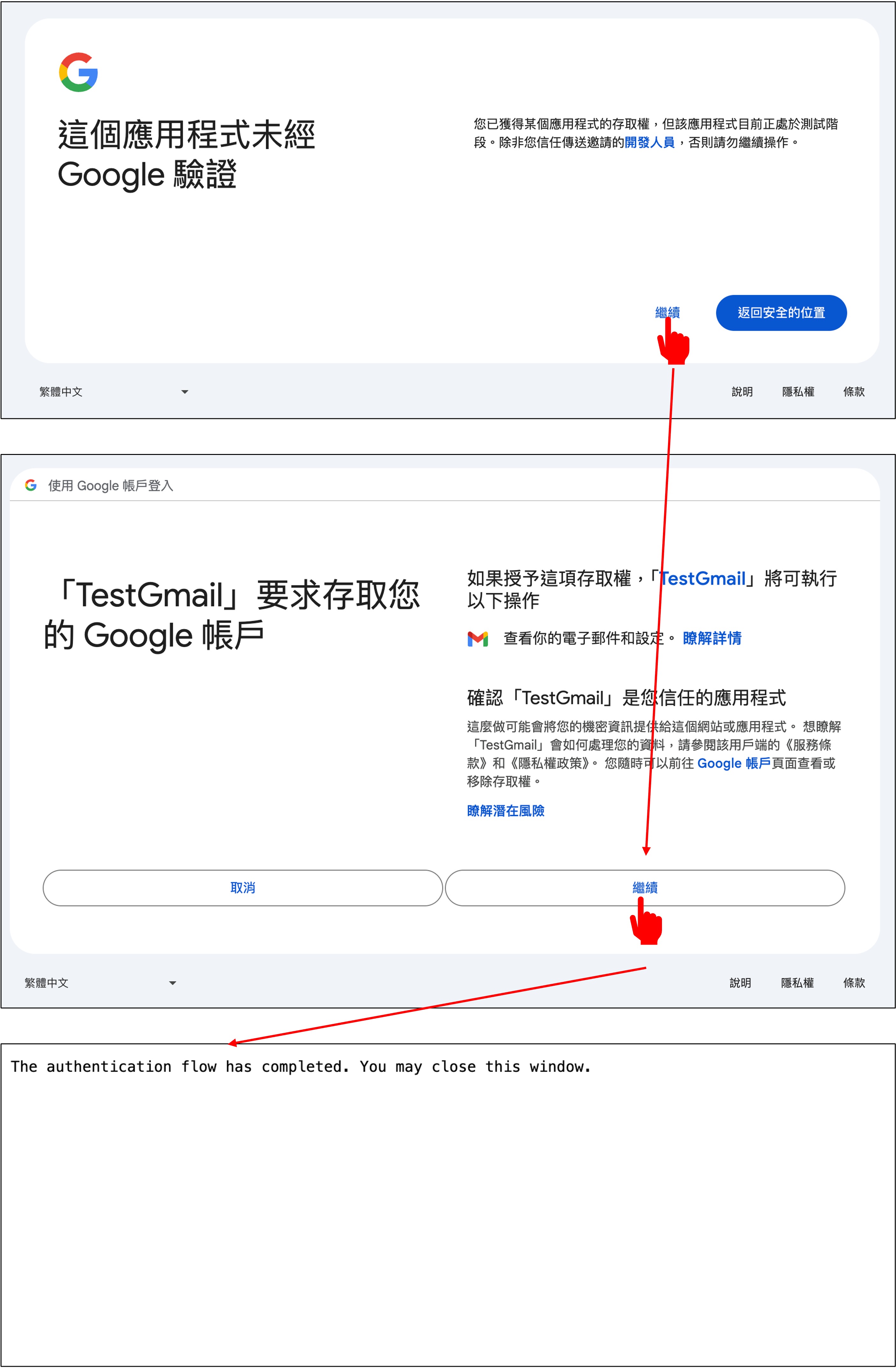Gmail API の呼び出し
設定が完了したら、Gmail API を使用し始めることができます。
まず、先ほどダウンロードしたcredentials.jsonファイルを見つけ、それをプロジェクトのルートディレクトリに配置します。
次に、Google が提供しているチュートリアルを開きます:Python quickstart
パッケージのインストール
Python 用の Google クライアントライブラリをインストールする必要があります:
pip install -U google-api-python-client google-auth-httplib2 google-auth-oauthlib
設定例
-
作業ディレクトリに
quickstart.pyという名前のファイルを作成します。- Google が提供するソースコードをそのまま使うこともできます:source code
-
以下のコードを
quickstart.pyに追加します:quickstart.pyimport os.path
from google.auth.transport.requests import Request
from google.oauth2.credentials import Credentials
from google_auth_oauthlib.flow import InstalledAppFlow
from googleapiclient.discovery import build
from googleapiclient.errors import HttpError
# If modifying these scopes, delete the file token.json.
SCOPES = ["https://www.googleapis.com/auth/gmail.readonly"]
def main():
"""Shows basic usage of the Gmail API. Lists the user's Gmail labels."""
creds = None
# The file token.json stores the user's access and refresh tokens, and is
# created automatically when the authorization flow completes for the first
# time.
if os.path.exists("token.json"):
creds = Credentials.from_authorized_user_file("token.json", SCOPES)
# If there are no (valid) credentials available, let the user log in.
if not creds or not creds.valid:
if creds and creds.expired and creds.refresh_token:
creds.refresh(Request())
else:
flow = InstalledAppFlow.from_client_secrets_file(
"credentials.json", SCOPES
)
creds = flow.run_local_server(port=0)
# Save the credentials for the next run
with open("token.json", "w") as token:
token.write(creds.to_json())
try:
# Call the Gmail API
service = build("gmail", "v1", credentials=creds)
results = service.users().labels().list(userId="me").execute()
labels = results.get("labels", [])
if not labels:
print("No labels found.")
return
print("Labels:")
for label in labels:
print(label["name"])
except HttpError as error:
# TODO(developer) - Handle errors from gmail API.
print(f"An error occurred: {error}")
if __name__ == "__main__":
main()
実行例
quickstart.pyを実行します:
python quickstart.py
quickstart.pyを初めて実行すると、認証を求められます。「Allow」をクリックしてください。

次のような出力が表示されます:
Labels:
CHAT
SENT
INBOX
IMPORTANT
TRASH
DRAFT
SPAM
CATEGORY_FORUMS
CATEGORY_UPDATES
CATEGORY_PERSONAL
CATEGORY_PROMOTIONS
CATEGORY_SOCIAL
STARRED
UNREAD
また、token.jsonというファイルが取得され、次回quickstart.pyを実行する際に再度認証を求められることはなくなります。
使用開始
次に、Gmail API を使用してメール内容を解析する準備を始めます。
以下の三つの部分を実装します:クライアントの作成、メールの取得、メールの解析。
まず必要なパッケージをインポートします:
from base64 import urlsafe_b64decode
from datetime import datetime, timedelta
from typing import Dict, List
import pytz
from google.oauth2.credentials import Credentials
from googleapiclient.discovery import build
クライアントの作成
Gmail API クライアントを作成するとき、token.jsonに保存されたユーザーのアクセスおよびリフレッシュトークンをロードし、アクセス令牌が期限切れの場合は自動的にリフレッシュされます。
def build_service():
creds = None
token_file = 'token.json'
creds = Credentials.from_authorized_user_file(
token_file, scopes=['https://www.googleapis.com/auth/gmail.readonly'])
service = build('gmail', 'v1', credentials=creds)
return service
メールの取得
次に、ユーザーからメール内容を取得する関数を定義します:
def get_messages(
service,
user_id='me',
after_date=None,
subject_filter: str = None,
max_results: int = 500
) -> List[Dict[str, str]]:
tz = pytz.timezone('Asia/Taipei')
if not after_date:
now = datetime.now(tz)
after_date = (now - timedelta(days=1)).strftime('%Y/%m/%d')
messages = []
try:
query = ''
if after_date:
query += f' after:{after_date}'
if subject_filter:
query += f' subject:("{subject_filter}")'
response = service.users().messages().list(
userId=user_id, q=query, maxResults=max_results).execute()
messages.extend(response.get('messages', []))
# Handle pagination with nextPageToken
while 'nextPageToken' in response:
page_token = response['nextPageToken']
response = service.users().messages().list(
userId=user_id, q=query, maxResults=max_results, pageToken=page_token).execute()
messages.extend(response.get('messages', []))
except Exception as error:
print(f'An error occurred: {error}')
if not messages:
print("No messages found.")
return messages
メールの解析
データを取得した後、その内容は大量のメタデータを含んでいるため、読みやすい形式に解析する必要があります。
def parse_message(service, msg_id, user_id='me'):
try:
message = service.users().messages().get(
userId=user_id, id=msg_id, format='full').execute()
headers = message['payload']['headers']
parts = message['payload'].get('parts', [])
email_data = {
'Date': None,
'Subject': None,
'Text': None
}
# 解析ヘッダー情報(送信日時、件名、送信者、受信者)
for header in headers:
if header['name'] == 'Date':
email_data['Date'] = header['value']
elif header['name'] == 'Subject':
email_data['Subject'] = header['value']
# メール本文の解析
for part in parts:
if part['mimeType'] == 'text/plain' or part['mimeType'] == 'text/html':
data = part['body']['data']
text = urlsafe_b64decode(data.encode('ASCII')).decode('UTF-8')
email_data['Text'] = text
break # 最初に一致した部分のみを取得
return email_data
except Exception as error:
print(f'An error occurred: {error}')
return None
まとめ
ここまでで、Gmail API の基本的な使用方法について説明しました。
次に進む前に、いくつか準備が必要です。
OpenAI の API と接続し、メール内容を ChatGPT に送信して解析を行えるようにします。